Basic guppy genetics
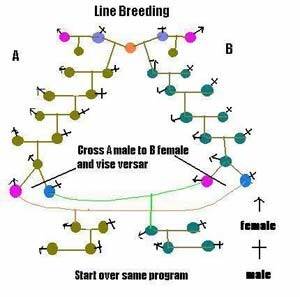
Sex chromsomes in guppies.
In general, we speak about X and Y sex chromosomes to make a distinct diffence in males and females. Although, the combination XX stands for female specimens and XY for male specimens in guppies, in guppies there's also another combination possible to determine the sex. These combinations are: XX, XY and YY. The combination YY are all males.
Guppy genetics
Genetic terms “Dominant”, “Recessive”, “Heterozygous” & “Homozygous” and its implication on your breeding program
For instance, when your cross a grey guppy (GG) with a gold guppy(gg), your will get guppy of these four different genotype (GG), (Gg), (gG) & (gg). All 3 fish with genotype (GG), (Gg), (gG) will turn out to be a grey guppy, in this case gene (G) is considered dominant over other gene (g).
Recessive – A gene in which the trait it represent will not show because its dominated by another gene it pair with is considered recessive.
Refer to the example above, those guppy with genotype(Gg) will turn out to be grey instead of gold because the gold gene (g) is recessive. Only instance when you can have a gold body guppy is when the guppy have this genotype (gg).
Homozygous – Paired genes that are the same at the same locus(location). Using the above example we can say that a gold body guppy has homozygous gold body trait.
Heterozygous – Paired genes that are different. Referring to the example above, the grey guppy with (Gg) & (gG) genotype are heterozygous.
We commonly refer a heterozygous guppy as one that does not breed true
We commonly refer a homozygous guppy as one that breed true
Genes/colors and their location,
Body colors (all autosomal) are:
– grey – dominant over all over body colors
– gold/tiger/bronze – recessive
– blond/gold – recessive
– albino/rrea – recessive, there are two different genes which cause the albino phenotype and which can’t be differentiated
– lutino/wrea – recessive
– there are three types of blau: one blau –gene shows no red and no yellow
another blau gene could show reduced red but no yellow
and the other blau gene (this one is called “hellblau”, this is a German word which means light blue) could show yellow e.g. snake skin
– pink is something special because of its peculiarities, it has a reduced number of the big black colour cells (melanophores) and it looks like tiger in its pure manifestation (without the hb). In the combination with the Nigrocaudatus 2 gene (it’s the gene for half black/tuxedo) the back becomes pink, that was the reason for the name “pink”, because the first guppies with this body colour where pink half blacks. It is suspected that they have also an increased number of iridophores. – cream – double recessive, gold + tiger
– white – double recessive, blau + gold
– silver – double recessive, blau + tiger
– “super white” – triple recessive, blau + gold + albino
– you can breed more combinations but only for these double and triple recessive body colors exists a specific name (some but not all colors).
1. colors for the fore-body (the belly, until the beginning of dorsal in their original appearance):
– coral is a metallic red which is in most cases y-linked but there should be one x-linked strain in Germany too. In Germany we call it “neon” . In the combination with one of the blau genes it becomes light blue.
– moscow is a y-linked gene in most cases but there are some x-linked strains too. It is a metallic silver until dark blue colour. The intensity depends of the mood of the male. You can find this gene in metal heads (y-linked moscow + y-linked snake skin) or moscow blues (y-linked moscow + y-linked blue + x-linked blue) or in moscow greens and moscow purples
– Schimmelpfennig Metall (this is the original German name) or platinum is a metallic white/yellow/bright purple/bright blue. It is y-linked in most cases but there are some x-linked strains e.g. in Japan too.
– lazuli is a light blue which is y-linked (I don’t know it for sure, because only the Japanese breed it and in Europe there are no lines of this strain, so I had to use a online-translation which could be wrong)
2. colors for the lower-back:
– half black (it is the Nigrocaudatus 2 gene) is a x-linked gene in most cases but there are some y-linked strains too. It is a more or less black colour. It could become dark blue too after some selective breeding ( you have to increase the number of iridophores which lay above the melanophores) . In combination with the platinum it seems to be greenish.
– japan blue/aquamarine is a light blue which is a y-linked gene in most cases but there are some x-linked strains too.
– Störzbach (Stoerzbach) metal is a recessive and autosomal metallic blue, but in combination with other colour-genes it makes them a metallic colour e.g. Micariff (Stoerzbach metal + snake skin)
There are a lot of colors which consists of several different genes for example full reds. There are 6 (perhaps more) different genes for red and they can be y-linked, x-linked and autosomal, some are dominant and others are recessive, so it’s very difficult to talk about reds and full reds. Some colors are shown on the whole body e.g. snake skin. And some colors are shown on the body and the fins e.g. blues (in blue delta IFGA strains), parrish and hutter greens, snake skins, reds, purples, 3/4 blacks etc.
The problem is that some body-colors or normal colors also effect the form of the caudal e.g. you cannot create a half black double sword. There are some genes which are not really a colour like red, but the effect the caudal form too. The x-linked gene “cp” is such a gene. It causes a dark pigmentation of the caudal and together with the “double sword-gene” it causes a delta tail. The delta tail always consists of two or more genes. There has to be the “double sword-gene” (which can be y- or x-linked) and a colour gene for the caudal. Sometimes the male has both necessary genes or the female has both genes or each sex has only one of these genes, but in all these case you got a delta tail.
The genetics of the guppy can be very complex and to create a new strain of guppy, that will take a good time investment and a lot of energy.
Only the male can show y-linked traits. But they can also show x-linked traits or a mix of y- and of x-linked traits. Y-linked means that the gene(s) for this trait are on the Y-chromosome. It’s the same with x-linked.
Females can’t show all traits because there is a lack of some special color cells in their skin. They have all kinds of color cells but they have less cells of certain kinds than the males.
If a y-linked gene becomes x-linked because of a crossing-over, the appearance of the phenotype of this trait on the females could be the same as on the males. But sometimes there are some changes in the appearance e.g. japan blue. Females with x-linked japan blue don’t show any blue on the body, they only show sometimes some blue on the caudal. Full gold females show that females have enough iridophores to show metallic colors. If you see the same genotype (same genes), doesn’t always mean the same phenotype (this what you can see with your eyes if you look on the fish) of both sexes.
It’s like every science: there are more questions than answers and even if I got the answer to one question there are two new questions in this one answer.
Outcrosses
When making outcrosses you want to cross with lines that you are pretty sure are going to give the desired results. Somewhere around 80% to 90% of outcrosses produce fish that are inferior to both parents. When you are selecting which strains of fish you would like to work with, it is advantageous to select lines that can be used to improve each other. Over the years I nave Kept a mental catalog of the crosses that have worked well. Today, these crosses are the backbone of my breeding program. Below are some of the crosses that have worked well. These are pretty well tested crosses so they should work for most lines of these colors.
Reds and H/B Reds: I will use the gold bodied red males into the gray bodied h/b red females to improve the h/b reds. First generation will give 100% h/b reds. These are show stoppers. I then discard all the females from the cross and breed the males back to the pure gray bodied h/b red females. The downside of this cross is losing the deep h/b body color in the males. Always select the females with the darkest body color. (Note: you can create an excellent gray red line by saving some of the F1 females and crossing them back to the pure gold red males. The resultant offspring will be 25% gray reds.)
Reds and Albinos: I will cross the gold red males into the albino females to improve the albino line. The F1 is 100% gray reds. I then take these gray red males back to the pure albino females. Theoretically you should get 30% albinos, but I usually end up with 25-30%. You can then brother/sister these again for about three generations without much loss in vigor or fertility.
Purples and Greens: One of the best kept secrets in the hobby! This cross works both ways and will produce some excellent blues as well. The purple is dominant and will darken the greens considerably. With this in mind, use the lightest green colored male into the purple females to produce bigger and better greens. To improve the purples, cross the purple males into the green females. To select the grown females from the hybrid cross, shine a flashlight on them at night with the lights turned off. The green females will have a green crescent at the base of the peduncle and the purple females will have a purple crescent.
Variegated Yellow Snakeskin and H/B AOC (leopard): To improve the pattern in the h/b Aocs, cross the snake males into h/b females. In my lines the h/b is X linked and dominant. This means that the resulting offspring will all be h/b. Take the best male from the cross and breed them back to the pure h/b females. I use this cross about every 5 or 6 generations in my h/b aoc line.
H/B Pastel and Pastels: To improve the size and finnage of the pastels, cross a gold bodied white pastel into a gray bodied h/b pastel female. The offspring from this cross will be washed out gray bodied h/b pastels. Take the best of these males and breed them back to the pure gold bodied pastel females. The offspring will be 50% gold bodied pastels. These will be bigger and more vigorous than the original pastel line.
Blue/Green Bicolors and Yellow Variegated Snakeskins: Take the largest blue/green male (don’t worry too much about the color pattern) and cross this fish with the snake females. Take the males from this cross and breed them back to the bl/gr females.
Nigrocaudatus 1 = total black body (X-linked)
Nigrocaudatus 2 = half black body (mostly X-linked but there are also Y-linked strains). But also ¾ black is still considered Nigrocaudatus 2.

The nigrocaudatus 1 gene is rare in comparison to the nigrocaudatus 2 gene. Opinions of several breeders and scientists differ when it comes to the nigrocaudatus gene wether it's dominant or recessive in passing through to new offspring. But sure is the fact that both heterozygote females, with XNiXni genotypes, and homozygote ones, with XNiXNi genotypes, express the character in a lower dose than the male which is hemizygote (XNiY). A good example are moscow guppies. The male will show the nigrocaudatus phenotype more than a females does. She will show less dark coloration on the body but does carry the dominant moscow gene.
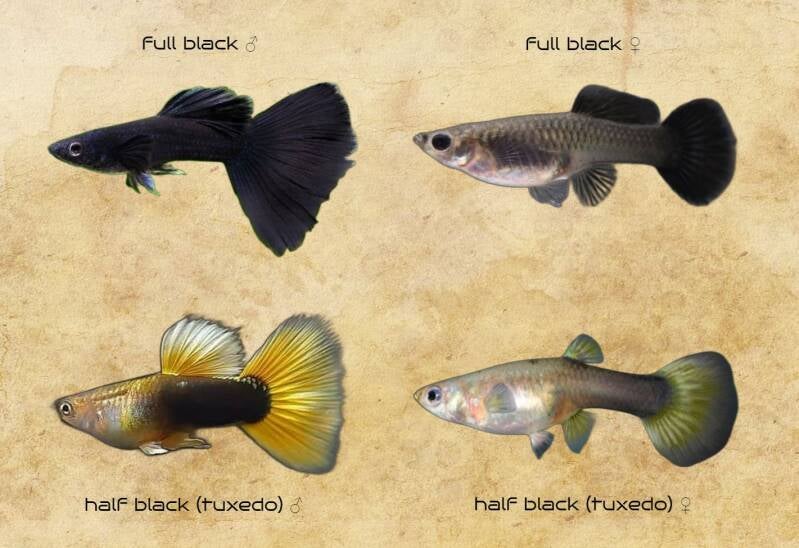
Above: Full black and half black male guppies are more intense black than the females of the same strain.
Females can’t show all traits because there is a lack of some special color cells in their skin. They have all kinds of color cells but they have less cells of certain kinds than the males
Purple moscow & green moscow
As already been mentioned before this is one of the best kept secrets in the hobby! This cross works both ways and will produce some excellent blues as well. The purple is dominant and will darken the greens considerably. With this in mind, use the lightest green colored male into the purple females to produce bigger and better greens. To improve the purples, cross the purple males into the green females. To select the grown females from the hybrid cross, shine a flashlight on them at night with the lights turned off. The green females will have a green crescent at the base of the peduncle and the purple females will have a purple crescent.
Metalheads
The socalled metalhead guppies are a result of a cross between a male moscow guppy x a non moscow female guppy.
Male metalheads have a dark or metal looking coloration on the head and chest area. Because the in moscow guppies, it's the female which has got the dominant moscow gene and the male the recessive moscow gene. If you'd cross a female moscow guppy to a non moscow male, the male offspring will have more dark on the body.
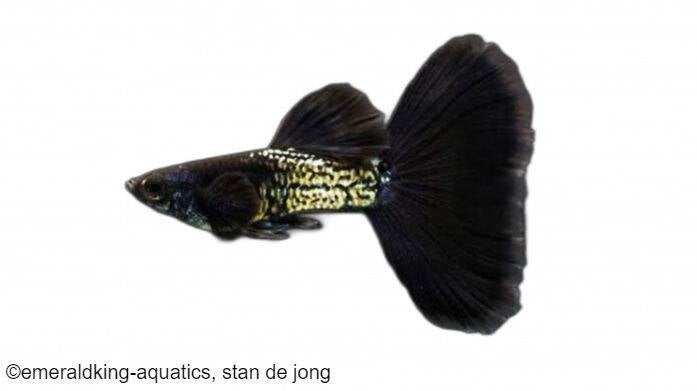
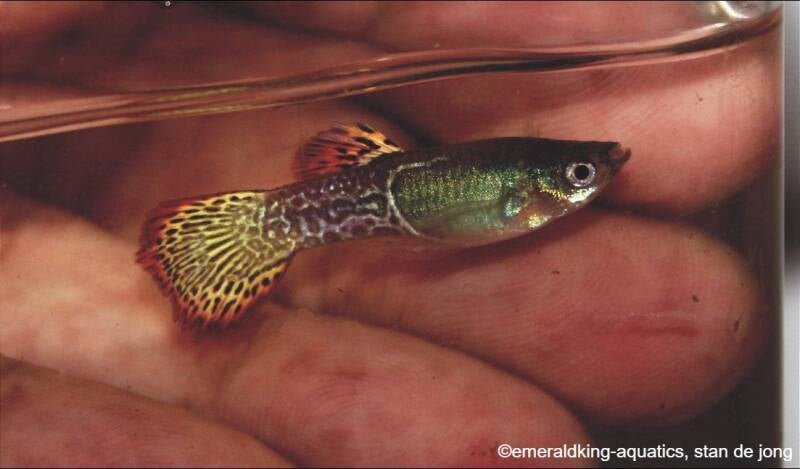
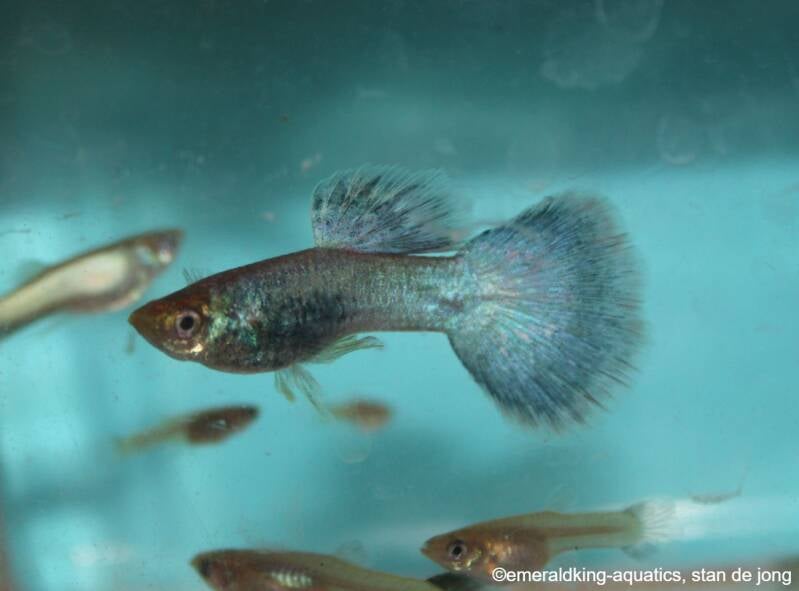

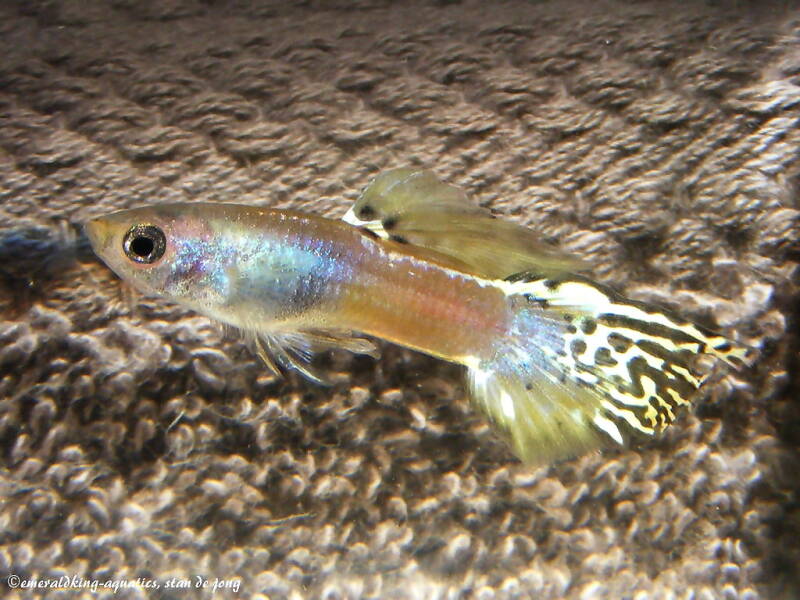
Above: Some male metalhead guppies.
Reference:
yonathanguppy.wordpress.com/2010/07/06/genetic-guppy
Symbols of alleles:
Dominant alleles
M: The presence of melanin (black pigment)
G: The presence of guanine (conditionally blue pigment)
E: The presence of astaxanthin quantity and other carotenoids (red pigment)
X: The presence of lutein (yellow pigment)
Recessive alleles
m: The lack ofr reduction of melanin quantity (black pigment)
g: The lack or reduction of guanine quantity (conditionally blue pigment)
e: The lack or reduction of astaxanthin quantity and other carotenoids (red pigment)
x: The lack or reduction of lutein quantity (yellow pigment)
Two basic rules for above:
1.) Recessive alleles of every color gene reduce size of pigment granules which are responsible for color expression of those genes and in phenotype color is absent.
For instance: If genotype is: mmGGEEXX size of melanin granules in melanophores is reduced and fish is lacking black and grey colors in base body colors and in surface colors. Hue is smoked.
2.) The higher number of recessive color genes alleles in genotype (ie. MmGgEeXx vs MMGGEEXX) the lower number of all pigment cells.
Ratio of dominant and recessive alleles of four genes illustrated in this way cause appearance of all possible phenotypes of base body colors as well as surface colors.

Above: Courtesy by W.Storozew and S. Apriatin.
4 Genes = 4 base color (black, red, yellow and blue/white)
Classical mendelian inheritance for each gene - dominant (M,G,E and X) and recessive (m.g.e and x) and interaction between these genes.
For instance, if we cross between 5-7 pairs with genotypes "MM, GG, ee, xx" and "mm, gg, EE, XX" in F2 generation we recieve all 16 variants of colors genotype.
Albinism in fish.
Albinism: Albinism is a group of disorders passed down in related specimens where the body makes little or none of a substance called melanin. The type and amount of melanin in the body determines the color of the skin, scales and eyes. When a specimen has got abinism in the eyes, it will affect its vision.
Fish with albinism have red eyes. A clear proof of lacking melanin in the eyes. Because melanin is missing, the eyes are more sensitive to light and a causes a bad eye sight. Moreover when the iris doesn't contain enough pigment, for daylight or other light is allowed to shine through the iris. So, best is to lower the light intensity in a tank when albinos are kept.
If a specimen has got a white or pale skin (or scales) and red eyes, such a specimen is called an "oculocutaneous albino" (OCA). This name is a contraction of "oculo" which means eyes and "cutaneous" which means skin. But when a specimen has got only red eyes but not a white or pale body color, such a specimen is called an "ocular albino". As described before both ocular and oculocutaneous albino are called "Real Red Eye Albino" (RREA).
Another form of albinsim is lutism. Specimens with lutism in the eyes still have a low concentration of melanin. Such a specimen is called a "lutino". As described earlier, lutino is also called "Wine Red Eye Albino" (WREA). The red eyes are darker red than in real albinos. And also a lutino specimen will be very sensitive to light.
And again, both albino and lutino are autosomal recessive. And it's not correct to state that albinos are blind. For that's something I do read from time to time at relevant sites.
Note: A white fish with black eyes is not an albino nor a lutino. Such a specimen is called a leucistic specimen.

DEFINITIONS
Alleles: Alternate forms of the same gene. An allele is a section of a gene that is responsible for a certain characteristic.
Domestication: To bring or keep (wild animals or plants) under control or cultivation. http://dictionary.reference.com
Dominance: One gene contributes more, or less, to the final phenotype. In complete dominance one allele completely hides the effect of the other allele; while in the case of incomplete dominance, the phenotype is part way between the phenotype of the two homozygous forms of the allele.
Heterozygosity: If two different alleles for a specific gene are present.
Homozygosity: When an allele inherited from a male is the same as the one inherited from the female.
Inbreeding Depression: A reduction in fitness due to the mating of closely related and often genetically similar individuals; creating a loss of robustness due to expression of deleterious recessive alleles. This may result in an inability to respond to selection from lack of residual heterozygosity.
Inbreeding: The mating of highly related individuals such as father to daughter or brother to sister. An inbred individual or population often shows increased homozygosity. Progeny may exhibit a reduction in desired genes or loss of fitness.
Linebreeding: Planned mating to maintain a high degree of relation to a common ancestor or ancestral group of high regard. The intent is to avoid a reduction in desired genes or loss of fitness. A linebred individual has at least one common ancestor on the male and female side within 3-5 generations.
Meiosis: A type of cell division which reduces chromosome numbers by half. Two successive nuclear divisions occur, Meiosis I (Reduction - ploidy level from 2n to n) and Meiosis II (Division - divides the remaining set of chromosomes). Meiosis produces 4 haploid cells, while Mitosis produces 2 diploid cells.
http://www2.estrellamountain.edu/faculty/farabee/biobk/biobookmeiosis.html#Meiosis
Mutation: A mutation is a permanent change in the DNA sequence of a gene. Mutations in a gene's DNA sequence can alter the amino acid sequence of the protein encoded by the gene. http://learn.genetics.utah.edu/archive/mutations
Nonadditive Gene Interaction: Non-additive gene interactions include the effects of dominance of one allele over another and epistatic effects of one gene (or gene pair) on another, non-allelic gene (or gene pair).
Outcrossing: The mating of unrelated or distantly related individuals. This results in increased heterozygosity.
QTL: Quantitative Trait Loci – Section of DNA (the locus) correlating to variation in a phenotype. Statistical analysis is then used identify linkages with genes controlling phenotype.
A new dominant autosomal mutation of Lebistes reticulatus is described, causing a veil-like elongation of fins and increased dichotomous branching of fin rays. The dominant gene Kal, responsible for the formation of veil-fins, can be suppressed by a non-allelic dominant factor Sup. Kal and Sup belong to two different linkage groups. Either Kal or Sup are linked with the dominant allele of the recessive xanthoric factor "blond", because blond veil-fin guppies could not be obtained by recombination. Homozygosity for the recessive wildtype alleles of the gene for veil-fins and of its suppressor, (i.e. + (Kal) /+ (Kal) , + (Sup) /+ (Sup) ) seems to result in postnatal lethality of the males.

